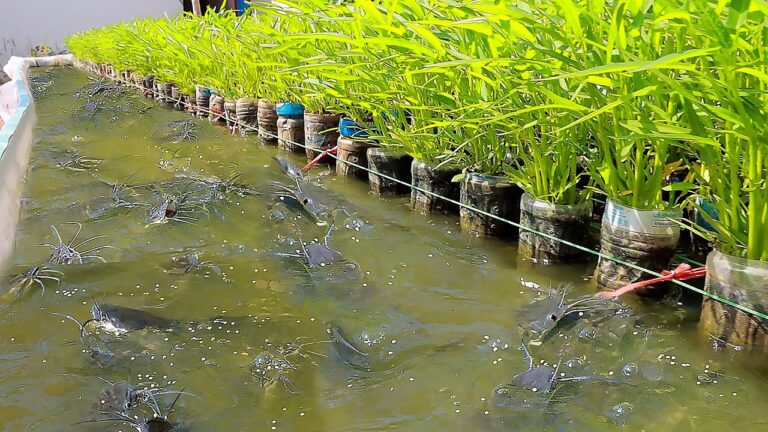Introduction
In a world grappling with environmental challenges, the innovative repurposing of everyday items holds the key to sustainable living. This article explores an extraordinary approach to sustainable agriculture, focusing on the transformation of 1500 plastic bottles into a backyard aquaponics system. This system not only cultivates fresh fish but also nurtures the growth of water convolvulus, providing a holistic and eco-friendly solution to home-based food production.
Learn How Using 1500 Plastic Bottles for Backyard Aquaponics Helps in Farming Fresh Fish and Growing Water Convolvulus
Public Facts About Convolvulus
Convolvulus is a genus of about 200 to 250 Species of flowering plants in the bindweed family Convolvulaceae, with a cosmopolitan distribution. Common names include bindweed and morning glory; both names shared with other closely related genera.They are annual or perennial herbaceous vines, bines and (a few species of) woody shrubs, growing to 0.3–3 m tall.
The leaves are spirally arranged, and the flowers trumpet-shaped, mostly white or pink, but blue, violet, purple, or yellow in some species. Convolvulus species are used as food plants by the larvae of some Lepidoptera species, including the convolvulus hawk moth, the sweet potato leaf miner (Bedellia somnulentella) and the gem; the leaf miner Bucculatrix Cantabricella feeds exclusively on C. Cantabricus.
The Marriage of Aquaponics and Plastic Bottle Repurposing
Aquaponics is a symbiotic system that combines aquaculture (fish farming) with hydroponics (soilless plant cultivation). Integrating this technique with the repurposing of 1500 plastic bottles unveils a harmonious ecosystem where fish waste nourishes plants, and plants purify water for the fish. This dynamic relationship exemplifies the potential of sustainable practices in addressing both food and environmental concerns.
Transforming Plastic Bottles into Aquaponic Components
Repurposing plastic bottles for aquaponics involves converting them into essential components of the system. Cut and modify the bottles to create grow beds, fish tanks, and plumbing elements. Ensure that the bottles used are clean and free from contaminants, creating a safe environment for both fish and plants.
Constructing the Aquaponics System
The construction of a backyard aquaponics system using 1500 plastic bottles requires careful planning and execution. Establish a solid foundation for the fish tank and arrange the plastic bottles into grow beds. Integrate a water circulation system that allows the fish waste-rich water to irrigate the plants, creating a closed-loop ecosystem. Watch the Video.
Selecting Fish for Backyard Aquaponics
Choosing the right fish species is crucial for the success of the aquaponics system. Opt for species that thrive in confined spaces, such as tilapia or catfish. These fish produce nutrient-rich waste that becomes a vital fertilizer for the water convolvulus. Create a balanced ecosystem where fish contribute to plant growth, and plants help maintain water quality.
Water Convolvulus: The Ideal Companion Plant
Water convolvulus, also known as water spinach, is an excellent choice for aquaponic cultivation. Its versatile nature makes it suitable for hydroponic systems, thriving in nutrient-rich water. The plant serves a dual purpose by absorbing excess nutrients from the water, enhancing water quality for the fish, and providing a nutritious addition to the human diet.
Nutrient Cycling and Sustainability
The beauty of aquaponics lies in its ability to create a sustainable and efficient nutrient cycling system. Fish waste is converted into nitrates by beneficial bacteria, which are then absorbed by the water convolvulus as a nutrient source. This closed-loop cycle minimizes the need for external fertilizers and ensures a self-sustaining ecosystem.
Maintaining Water Quality and Fish Health
Regular monitoring of water quality is essential to maintain a thriving aquaponics system. Implement a comprehensive maintenance routine, including testing water parameters, cleaning filters, and ensuring proper aeration. By prioritizing fish health and water quality, the system can achieve optimal productivity.
Scaling Up and Community Impact
The scalability of the backyard aquaponics system using 1500 plastic bottles opens the door to community-driven initiatives. Imagine neighborhoods collectively adopting this sustainable practice, not only for personal consumption but also to contribute to local food security. Workshops and community projects can facilitate knowledge sharing, fostering a sense of environmental responsibility.
Addressing Challenges and Innovating Solutions
No system is without challenges, and aquaponics is no exception. Addressing issues such as pests, diseases, and system imbalances requires innovation and adaptability. Encourage experimentation with eco-friendly solutions, promoting a culture of continuous improvement within the aquaponics community.
Educational Outreach and Future Prospects
The integration of aquaponics with plastic bottle repurposing presents exciting opportunities for educational outreach. Schools, community centers, and environmental organizations can collaborate to teach the principles of sustainable agriculture. By instilling a sense of environmental stewardship in future generations, we pave the way for a more sustainable and resilient future.
Conclusion:
In conclusion, the utilization of 1500 plastic bottles for backyard aquaponics represents a groundbreaking approach to sustainable living. This innovative system not only produces fresh fish and nutritious water convolvulus but also showcases the transformative power of repurposing everyday items for environmental conservation. Embrace this holistic solution, and be a catalyst for change in creating a more sustainable and harmonious relationship between humans and the environment.


